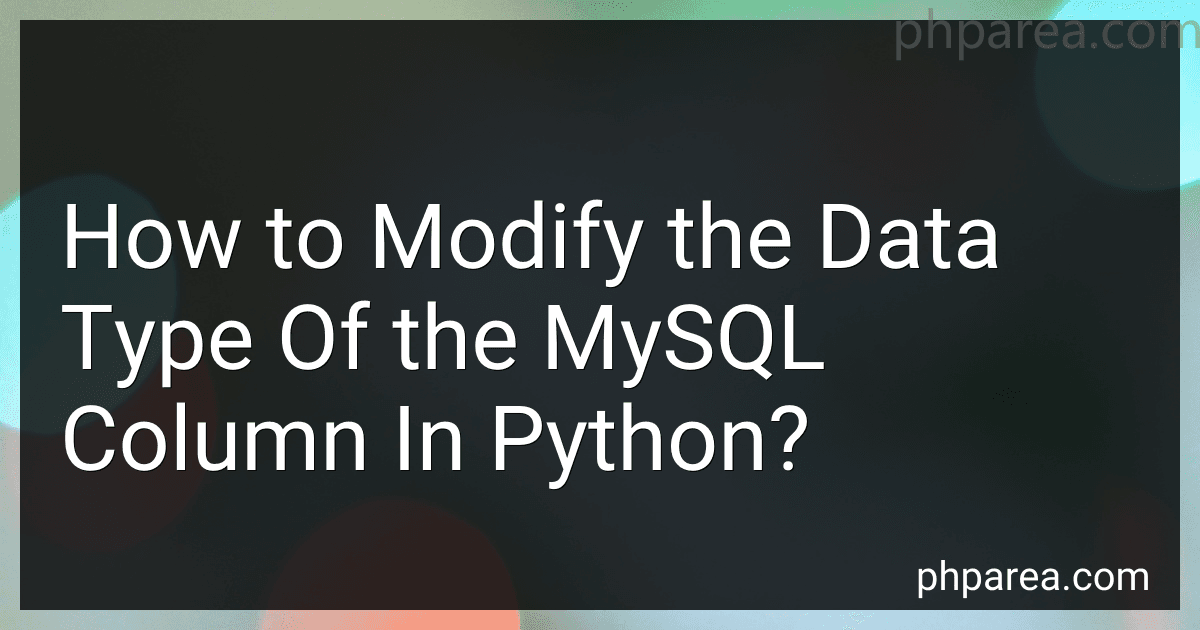Best MySQL Data Type Modification Tools to Buy in December 2025

High Performance MySQL
- QUALITY ASSURANCE: THOROUGHLY INSPECTED FOR GOOD CONDITION.
- AFFORDABLE PRICING: SAVE MONEY WHILE ENJOYING QUALITY READS.
- ECO-FRIENDLY CHOICE: SUPPORT SUSTAINABILITY BY BUYING USED BOOKS.



Head First PHP & MySQL: A Brain-Friendly Guide


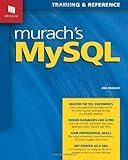
Murach's MySQL
- MASTER ESSENTIAL SQL STATEMENTS FOR MYSQL DATABASE SUCCESS.
- LEARN TO CREATE AND MANAGE ROBUST DATABASES EFFORTLESSLY.
- BOOST YOUR CODING SKILLS WITH HANDS-ON SQL TECHNIQUES.



Linux Server Hacks: 100 Industrial-Strength Tips and Tools
- QUALITY ASSURANCE: THOROUGH INSPECTIONS ENSURE A GOOD CONDITION.
- COST-EFFECTIVE: AFFORDABLE ALTERNATIVE TO NEW BOOKS WITHOUT COMPROMISE.
- ECO-FRIENDLY CHOICE: SUPPORTS SUSTAINABILITY THROUGH BOOK RECYCLING.


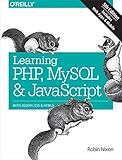
Learning PHP, MySQL & JavaScript: With jQuery, CSS & HTML5 (Learning PHP, MYSQL, Javascript, CSS & HTML5)



Build a real Search Engine: Engineering tools: HTML, CSS, JavaScript, PHP, MySQL


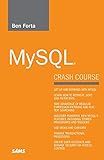
MySQL Crash Course


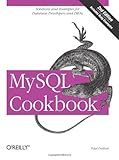
MySQL Cookbook
- AFFORDABLE PRICES FOR QUALITY READS: SAVE BIG ON EXCELLENT BOOKS!
- ECO-FRIENDLY CHOICE: REDUCE WASTE BY BUYING PRE-LOVED BOOKS!
- CURATED SELECTION: DISCOVER HIDDEN GEMS AND POPULAR TITLES ALIKE!



AWS Lightsail setup, tricks and tools: DNS Zones, PHP, mySQL, SSL Cert, VHosts, metric, bots and all you need to succeed


In Python, you can modify the data type of a MySQL column using SQL ALTER statements through the MySQL Connector/Python library. Here's an overview of the process:
- Import the MySQL Connector/Python library:
import mysql.connector
- Establish a connection to your MySQL database:
mydb = mysql.connector.connect( host="localhost", user="yourusername", password="yourpassword", database="yourdatabase" )
- Create a cursor object to execute SQL queries:
mycursor = mydb.cursor()
- Use the ALTER TABLE statement to modify the data type of the column. For example, if you want to change the data type of a column named 'column_name' in a table named 'table_name' to 'new_data_type', you can execute the following SQL query:
mycursor.execute("ALTER TABLE table_name MODIFY column_name new_data_type;")
Replace 'table_name', 'column_name', and 'new_data_type' with your actual table, column, and desired data type names.
- Commit the changes to the database:
mydb.commit()
After running the above code, the data type of the specified MySQL column will be modified.
Remember to handle exceptions and close the database connection properly.
Note: The available data types may vary depending on your MySQL version. Refer to the MySQL documentation for specific data type options that you can use for modifying your columns.
How to perform a safe data type modification for a MySQL column using Python?
To perform a safe data type modification for a MySQL column using Python, you can utilize the following steps:
- Connect to the MySQL database using a library like pymysql or mysql-connector-python. Make sure to provide the necessary connection details (i.e., host, username, password, database).
import pymysql
Establish a database connection
db = pymysql.connect(host="localhost", user="username", password="password", database="database_name") cursor = db.cursor()
- Check the current data type of the column using DESCRIBE query. This will help you verify the current data type and the changes you want to make.
column_name = "your_column_name" table_name = "your_table_name"
Execute the DESCRIBE query to get the column info
cursor.execute("DESCRIBE {}.{}".format(table_name, column_name)) column_info = cursor.fetchone()
Print the current data type
print("Current data type of the column:", column_info[1])
- Perform a backup of the table to ensure data safety before making any modifications. This backup can be used later for restoration in case of any issues.
# Backup the table backup_table_name = table_name + "_backup" cursor.execute("CREATE TABLE {} SELECT * FROM {}".format(backup_table_name, table_name)) db.commit()
- Modify the column's data type using an ALTER TABLE query. You can specify the desired data type to change to in the query.
new_data_type = "your_new_data_type"
Alter the table to modify the data type of the column
cursor.execute("ALTER TABLE {} MODIFY COLUMN {} {}".format(table_name, column_name, new_data_type)) db.commit()
- Verify the data type modification by executing the DESCRIBE query again and checking the column info.
# Execute the DESCRIBE query after modification to verify the data type change cursor.execute("DESCRIBE {}.{}".format(table_name, column_name)) column_info = cursor.fetchone()
Print the new data type
print("Modified data type of the column:", column_info[1])
- Close the database connection.
# Close the database connection db.close()
By following these steps, you can safely modify the data type of a MySQL column using Python, ensuring data integrity and minimizing any potential risks.
How can I update the data type of a MySQL column in Python?
To update the data type of a MySQL column in Python, you can execute an ALTER TABLE statement using the MySQL Connector/Python library. Here's an example:
import mysql.connector
Connect to the MySQL server
cnx = mysql.connector.connect( host="localhost", user="your_username", password="your_password", database="your_database" )
Create a cursor object to execute SQL queries
cursor = cnx.cursor()
Execute the ALTER TABLE statement to modify the data type
alter_table_query = "ALTER TABLE your_table MODIFY COLUMN your_column new_data_type" cursor.execute(alter_table_query)
Commit the changes
cnx.commit()
Close the cursor and the connection
cursor.close() cnx.close()
Make sure to replace "localhost", "your_username", "your_password", "your_database", "your_table", "your_column", and "new_data_type" with the appropriate values for your scenario.
Note: Using ALTER TABLE to modify a column data type may lead to data loss or other issues if not done carefully. Ensure that you have proper backups and a clear understanding of the impact before making any modifications to your database schema.
What happens to the existing data when modifying the data type of a MySQL column in Python?
When modifying the data type of a MySQL column in Python, the existing data may be affected in the following ways:
- Data truncation: If the new data type has a smaller size than the existing one, data may get truncated or truncated values may be stored in the column. For example, if a column of type VARCHAR(100) is modified to VARCHAR(50), any values exceeding 50 characters will be truncated.
- Data loss: If the new data type cannot accommodate the values in the existing column, data loss may occur. For instance, changing a column from INTEGER to BOOLEAN may lead to the loss of non-boolean values.
- Conversion errors: During the modification process, some data may fail to convert from one data type to another. This can occur if the values can't be interpreted according to the new data type. In such cases, errors may be thrown, and the conversion process may fail.
It is important to properly handle data type modifications and consider any potential impact on the existing data when making such changes. It is recommended to backup the database before performing any modifications to ensure data integrity and avoid unintentional data loss.
How to modify the data type of a MySQL column in Python?
To modify the data type of a MySQL column in Python, you can use the ALTER TABLE statement in SQL. Below is an example of how to do this using the mysql-connector-python library:
- Ensure that you have installed the mysql-connector-python library. If not, you can install it using pip:
pip install mysql-connector-python
- Import the necessary libraries:
import mysql.connector from mysql.connector import Error
- Establish a connection to your MySQL database:
try: connection = mysql.connector.connect( host='', database='<database_name>', user='', password='' )
if connection.is\_connected():
print('Connected to MySQL database')
except Error as e: print(e)
Make sure to replace <hostname>, <database_name>, <username>, and <password> with the appropriate values for your MySQL server.
- Create a cursor object to execute SQL queries:
cursor = connection.cursor()
- Use the ALTER TABLE statement to modify the data type of the column:
try: cursor.execute("ALTER TABLE <table_name> MODIFY COLUMN <column_name> <new_data_type>") print('Column data type modified successfully') except Error as e: print(e)
Replace <table_name> with the name of the table containing the column you want to modify, <column_name> with the name of the column, and <new_data_type> with the desired new data type for the column.
- Commit the changes and close the connection:
connection.commit() cursor.close() connection.close()
Make sure to call commit() to save the changes, and then close the cursor and connection.
That's it! By executing the above steps, you should be able to modify the data type of a MySQL column using Python.
